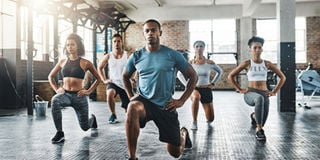Try lunges for a full body workout

Lunges can be done in a number of ways and are ideal for fitness levels of all kinds. NET PHOTO
What you need to know:
- Lunges help you strengthen your lower body, increase core strength, muscle tissue and help you get the perfect bum you always hoped for. Know the many benefits of lunges here.
A lunge can either be a single-leg bodyweight exercise that works your hips, glutes, quads, hamstrings, core, and the hard-to-reach muscles of the inner thigh or any position of the human body where one leg is positioned forward with the knee bent and foot flat on the ground while the other leg is positioned behind.
Elly Muhereza, a fitness and wellness coach, commends these exercises, saying they help one develop lower-body strength and endurance. He adds that unlike squats, lunges are highly effective at dealing with muscle imbalances.
Static lunges
This is usually the starting point for anyone trying out lunges. “It places pressure on the quads, hamstrings and glutes owing to robust unusual contraction your muscles are experiencing,” Benjamin Zabinga, a fitness trainer explains. He adds that the lunge will test your balance because all your weight is loaded on the forward leg. In a split position, lower your body in a lunge with both knees bent at a right angle. Loading most of your weight through the forward leg, the leg at the back is used to support and balance your body.
Walking lunges
This simple yet effective lunge targets one’s glutes and hamstrings. Zabinga says: “They place a huge demand on one’s cardiovascular system because one is activating so many primary muscles. They also help increase the challenge by varying your posture and weight.”
To do them, one must stand upright with their feet shoulder-width apart and hands on the hips. Then step forward with the right leg while placing the foot as one would for a static lunge and dropping your hips. Lower your left knee to the ground and just before it touches the ground, go up and forward through your right leg.
To place greater demand on your balance, Zabinga advises holding dumbbells in both hands to develop grip strength and placing a bar on your back. For better results, switch your lead legs back and forth, seeing that the leg behind is usually only stabilising the lunge but minimally involved in the exercise. Others include reverse lunges, alternating lunges, curtsy lunges, single leg lunges, and side lunges.
Positioning
Muhereza says the position and direction of the lunge will affect how much strain each muscle gets. He explains that moving forward or walking requires extra hip drive, meaning that one will use the hamstrings and glutes more. However, lunging in place, or keeping oneself more in a backward position involves more quads, as knee extensions increase and hip extension reduces.
That said, with feet further apart, hamstrings are in a more stretched position thus contributing more. “Hamstrings move more distance when one’s feet are further apart than when they are close. But when the feet are closer, it is the quads that play a bigger role as hamstrings stretch less and hip extension is felt more on the glutes,” Muhereza says.
Nonetheless, the quads, hamstrings and glutes are always working at whatever position is at during lunges. “When the knee extends, the quads are working, when the hip extends, the glutes and hamstrings are working,” he says.
Benefits of lunges
According to Muhereza, one of the benefits of lunges is improved balance. He says lunges work on both sides of the body, making them a unilateral exercise. “They work the front and back of the legs though in an alternate manner. That is to say, quadriceps on the left leg, hamstrings and glutes on the right leg and vice versa. That is why it is always good to do alternate leg lunges, so as to prevent muscle imbalances,” he explains.
Lunges also strengthen your buttocks and legs. They are also said to be one of the most effective exercises for your lower-body as they effectively work on your glutes and quadriceps and also engage your hamstrings. In so doing, one can get the perfect buttocks they have always hoped for, not forgetting toned legs.
They also improve the flexibility of one’s hip flexors (muscles you use to bend or flex your legs at your hips). If neglected, they can get tight and trigger low back pain.
They can be done from anywhere hence one is not confined to going to the gym. “You can do them in the comfort of your home seeing that no equipment is needed,” Muhereza concludes.
How to do a proper lunge
It is important to practice lunges properly. Not doing so can put too much pressure on your joints and may result in an injury. Here is how you must do a proper lunge:
1. Stand straight, keep your upper body straight, shoulders relaxed and chin up.
2. Keep one leg forward, lower your hips till both knees are bent at a 90 degree angle. Make sure that your knee is in line with your ankles.
3. Make sure that the other knee does not touch the floor.
4. Keep your body weight on the heels.
5. Now switch feet and repeat the same.




